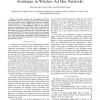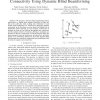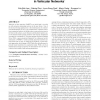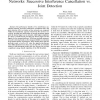43 search results - page 2 / 9 » A Game-Theoretic Framework for Interference Avoidance in Ad ... |
ICC
2007
IEEE
13 years 11 months ago
2007
IEEE
—The paper analyzes the relationships among the transmission range, carrier sensing range, and interference range in case that power control is adopted and proposes an adaptive r...
IFIP
2003
Springer
13 years 10 months ago
2003
Springer
In multi-hop wireless networks, every node is expected to forward packets for the benefit of other nodes. Yet, if each node is its own authority, then it may selfishly deny packe...
VTC
2008
IEEE
13 years 11 months ago
2008
IEEE
— We propose a dynamic blind beamforming scheme which allows to benefit from antenna directivity in large mobile ad hoc networks while avoiding heavy feedback to track mobile no...
MOBIHOC
2007
ACM
14 years 4 months ago
2007
ACM
Vehicular ad hoc networks (VANETs) are envisioned to provide us with numerous interesting services in the near future. One of the most promising applications is the dissemination ...
ICC
2009
IEEE
13 years 11 months ago
2009
IEEE
Abstract—The performance benefits of two interference cancellation methods, successive interference cancellation (SIC) and joint detection (JD), in wireless ad hoc networks are ...




